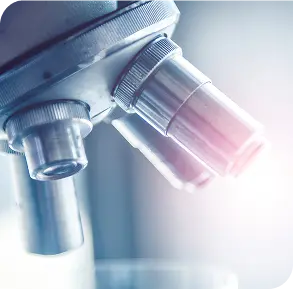Learn about H3 K27M. Ask About Testing

About Gliomas
Knowing your specific tumor can help you understand your options
A glioma is a brain tumor that starts in the brain or spinal cord and grows from glial cells, which are support cells within the nervous system. Gliomas can spread to surrounding healthy tissue, which may make them harder to treat with surgery or other therapies.
- Astrocytomas: Tumors that grow in star-shaped glial cells that help the brain function properly
- Glioblastomas: These tumors also form from star-shaped glial cells, but they are more aggressive
- Oligodendrogliomas: Tumors that form in cells that protect and support nerve cells in the brain and spinal cord
- Ependymomas: Tumors that develop in the fluid-filled spaces of the brain and spinal cord
- Mixed Gliomas: Tumors made up of more than one type of cell, such as a mix of star-shaped and support cells
How gliomas happen
Gliomas typically result from
Learning if the glioma has a mutation can help doctors develop a thorough management plan.
Whether you’re navigating glioma yourself or researching for a loved one, the more you know the better
About H3 K27M
What is an H3 K27M mutation?
H3
K27
Amino acids are the essential building blocks of proteins.
- There are 20 different amino acids that make up all proteins
- DNA determines where each amino acid is placed and in what order to make up a working protein
- Each amino acid is numbered based on its location in the sequence. For example, K27 refers to lysine (abbreviated “K”) in the 27th location in the amino acid chain that makes up the protein
M
Knowing if the glioma has the H3 K27M mutation is an important step in creating a management plan that's right for you or your loved one
Testing for H3 K27M
You won’t know if you don’t test for H3 K27M
Imaging tests like magnetic resonance imaging (MRI), computed tomography (CT), and positron emission tomography (PET) play an important role in diagnosing and managing gliomas. However, imaging alone won’t show if a glioma has a specific mutation, like H3 K27M.
Molecular testing has become more common and can reveal details that imaging cannot. The H3 K27M mutation can be detected using the following laboratory tests:

What's needed for laboratory testing?
If your doctor has decided IHC and/or NGS are needed to help guide treatment planning, a small piece of glioma tissue will be needed for these tests. To get this tissue, your doctor will discuss the next steps, including if a surgical procedure called aTalk to your doctor about testing for mutations.
Support
Discover support for you or a loved one
Local and national advocacy groups are available to provide support and services to you or the person you care for. Check your state for locally managed support groups. Some of the national support groups are listed here.
The ABTA provides clinically validated, up-to-date information for patients and caregivers facing a primary or metastatic brain tumor diagnosis. The ABTA supports patients of all ages with all brain tumor types. Information includes tumor and treatment overviews, financial assistance and support services, educational programming, caregiver resources, treatment center and support group locators, and research and clinical trials.
BTN is a nonprofit organization providing free, unparalleled, personalized neuro-oncology navigation services to individuals and families affected by primary brain tumors, guiding them through diagnosis and treatment options and providing supportive care to empower informed decision-making and improve quality of life throughout the duration of their unique brain tumor journey.
DIPG OneLink provides a road map for those new to the fight, in the fight, and fighting for others. DIPG OneLink highlights the best resources—from what to know when diagnosed to the community's My DIPG Navigators, the DIPG DMG National Brain Tumor Board, and a one-stop financial assistance network. Written by families for families, learn how to find the most cutting-edge treatment options, emotional support, and resources on DMG.
Get one-on-one support from a DIPG/DMG nurse navigator. With years of experience in pediatric oncology, these nurses will directly help you better understand the diagnosis and treatment options, connect you to proper resources you need, and support you at any time throughout your family's entire DIPG or DMG journey.
The website www.dipg.org offers in-depth advice, patient resources, and factual articles by nearly 40 experts in the field. For further patient support, the DIPG/DMG Warrior program brings patients together for peer support. Learn more at https://www.dipg.org/what-to-do-when-diagnosed/.
The Tough2gether Foundation is led by over 50 families who walk the path of diffuse midline glioma/diffuse intrinsic pontine glioma (DMG/DIPG) and other pediatric cancers together. Founded to connect, question, collaborate, and cure, the Tough2gether Foundation provides a lifeline to emotional and financial support for patients, parents, and siblings, along with clinical trial access, research funding, and advocacy for childhood cancer. Tough2gether welcomes patients of all ages and their families to reach out with questions, seek ideas for treatment and support, and find a meaningful connection with others in the DMG community.
If you have any additional questions, make a list and ask a doctor at the next available opportunity
FAQs
Frequently asked questions about glioma testing, H3 K27M–mutant diffuse glioma, and available support
H3 K27M–mutant diffuse gliomas are not inherited. They happen because of a mutation, or change, in the DNA of a glial cell. This mutation is not passed down from parents to children.
Testing helps doctors understand the tumor’s behavior and decide on the best management plan. It can help inform your treatment plan. Testing requires a biopsy, where a sample of the glioma is collected and sent to a lab for evaluation.
Caregivers play a vital role in supporting someone with an H3 K27M–mutant diffuse glioma. Here are some ways they can help:
- Emotional support: Be there to listen, comfort, and encourage. Help your loved one cope with the emotional challenges of their diagnosis and treatment
- Practical assistance: Manage appointments, medications, and daily tasks to reduce stress for your loved one
- Communication: Speak up for your loved one’s needs during medical visits and ensure their concerns are addressed
- Education: Learn about the condition and treatment options to better understand what your loved one is going through
- Quality of life: Help your loved one enjoy meaningful activities and moments, even during difficult times
- Self-care: Take care of your own physical and mental health to stay strong and effective as a caregiver
H3 K27M–mutant diffuse gliomas are serious and have a poor prognosis. The glioma may affect the way the brain functions, so it is important to take note of any changes you see in yourself or your loved one.
Ask about testing for H3 K27M today
Glossary
Amino acids are the essential building blocks of proteins.
- There are 20 different amino acids that make up all proteins
- DNA determines where each amino acid is placed and in what order to make up a working protein
- Each amino acid is numbered based on its location in the sequence. For example, K27 refers to lysine (abbreviated “K”) in the 27th location in the amino acid chain that makes up the protein
Antibodies are proteins made by the immune system to help protect the body. They recognize and attach to harmful invaders like viruses or bacteria, marking them so the body can fight them off.
Biopsy is a procedure where a sample of tissue is removed from a brain tumor and examined to help identify the type of tumor (eg, glioma) and how aggressive it is (Grade I-IV). Biopsies on brain tissue can be performed during surgery or through less invasive procedures like a needle biopsy.
DNA, or deoxyribonucleic acid, is a set of instructions that tell cells how to grow and function. It carries the information needed to make proteins, which are essential for your body to function properly.
Gene expression is the process by which cells read the instructions in their DNA to make useful products, usually proteins, that carry out the cell's function.
Oncogenic refers to something that causes or triggers tumor or cancer formation. It comes from “oncogene,” which is a mutated gene that disrupts normal cell growth, leading to uncontrolled cell division and cancer.
Proteins are molecules in the body that do important jobs, like building muscles and carrying oxygen in blood. They're made of smaller parts called amino acids, which are like building blocks.

